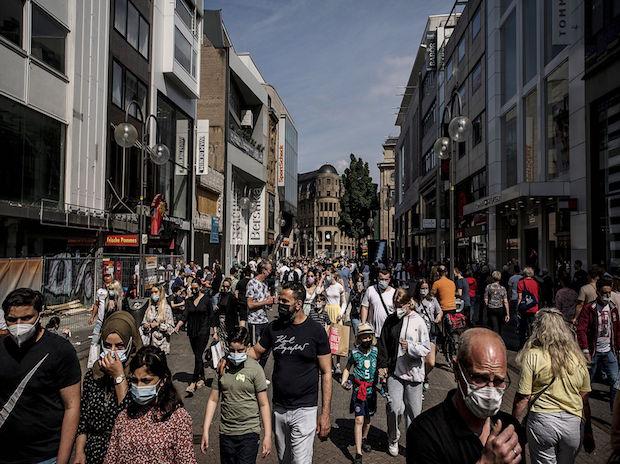US economy grows solidly in second quarter; weekly jobless claims fall

U.S. economic growth solidly in the second quarter as massive government aid and vaccinations against COVID-19 fueled spending on travel-related services.
Gross domestic product increased at a 6.5% annualized rate last quarter, the Commerce Department said on Thursday in its advance estimate of second-quarter GDP. The economy grew at a revised 6.3% rate in the first quarter
Economists polled by Reuters had forecast GDP rising at an 8.5% rate last quarter. With the second-quarter estimate, the government published revisions to GDP data, which showed the economy contracting 3.4% in 2020, instead of 3.5% as previously estimated. That was still the biggest drop in GDP since 1946.
The revisions to growth in other years and quarters were minor. From 2015 to 2020, GDP increased at an average annual rate of 1.1%, unrevised from previously published estimates.
The National Bureau of Economic Research, the arbiter of U.S. recessions, declared last week that the pandemic downturn, which started in February 2020, ended in April 2020.
Even with the second quarter marking the peak in growth this cycle, the economic expansion is expected to remain solid for the remainder of this year. A resurgence in COVID-19 infections, driven by the Delta variant of the coronavirus, however, poses a risk to the outlook. Higher inflation, if sustained, as well as ongoing supply chain disruptions could also slow the economy.
The Federal Reserve on Wednesday kept its overnight benchmark interest rate near zero and left its bond-buying program unchanged. Fed Chair Jerome Powell told reporters that the pandemic’s economic effects continued to diminish, but risks to the outlook remain.
FISCAL STIMULUS BOOST
Economists expect growth of around 7% this year, which would be the strongest performance since 1984. The International Monetary Fund on Tuesday boosted its growth forecasts for the United States to 7.0% in 2021 and 4.9% in 2022, up 0.6 and 1.4 percentage points respectively, from the forecasts in April.
President Joe Biden’s administration provided $1.9 trillion in pandemic relief in March, sending one-time $1,400 checks to qualified households and extending a $300 unemployment subsidy through early September. That brought the amount of government aid to nearly 6 trillion since the pandemic started in the United States in March 2020.
Nearly half of the population has been vaccinated against COVID-19, allowing Americans to travel, frequent restaurants and attend sporting events among services-related activities that were curbed early in the pandemic.
Though the fiscal boost is fading and COVID-19 cases are rising in states with lower vaccination rates, consumer spending will likely continue to grow.
Households accumulated at least $2 trillion in excess savings during the pandemic. Record high stock market prices and accelerating home prices are boosting household wealth. Wages are also rising as companies compete for scarce workers amid a strengthening labor market.
A separate report from the Labor Department on Thursday showed initial claims for state unemployment benefits fell by 24,000 to a seasonally adjusted 400,000 for the week ended July 24. Economists polled by Reuters had forecast 380,000 applications for the latest week.
Claims jumped in the week ended July 17, but economists blamed the surge on difficulties stripping out seasonal fluctuations from the data. Before the pandemic auto plants shut in early July for retooling, which caused a temporary rise in layoffs, which then reversed in the second half of July.
A global semiconductor shortage has forced some automakers to either scale back or temporarily idle production lines. (This story corrects the figure for first-quarter growth in the second paragraph to show it was revised down to 6.3% from 6.4%)
(Reporting by Lucia Mutikani; Editing by Dan Burns)
(Only the headline and picture of this report may have been reworked by the Business Standard staff; the rest of the content is auto-generated from a syndicated feed.)
 Dear Reader,
Dear Reader,
Business Standard has always strived hard to provide up-to-date information and commentary on developments that are of interest to you and have wider political and economic implications for the country and the world. Your encouragement and constant feedback on how to improve our offering have only made our resolve and commitment to these ideals stronger. Even during these difficult times arising out of Covid-19, we continue to remain committed to keeping you informed and updated with credible news, authoritative views and incisive commentary on topical issues of relevance.
We, however, have a request.
As we battle the economic impact of the pandemic, we need your support even more, so that we can continue to offer you more quality content. Our subscription model has seen an encouraging response from many of you, who have subscribed to our online content. More subscription to our online content can only help us achieve the goals of offering you even better and more relevant content. We believe in free, fair and credible journalism. Your support through more subscriptions can help us practise the journalism to which we are committed.
Support quality journalism and subscribe to Business Standard.
Digital Editor
business-standard.com

